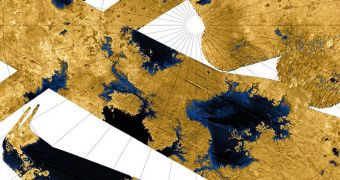Since July 1, 2004, when the Cassini spacecraft first achieved orbital insertion around Saturn, one of its primary targets has been the peculiar moon Titan. The space rock is covered by a thick, hazy atmosphere, and features lakes of liquid hydrocarbons (such as methane and ethane) at its north and south poles. All that made it a prime target for astrobiologists and planetary chemists, who have been browsing through Cassini data for many years. In two newly-published research papers, experts say that they may have found chemical signatures of processes that may be related to primitive life.
In their investigations, the scientists admit that some of the signature may be explained through non-biological chemistry, but add that previous researches have evidenced that there really is no reason to believe the moon could not sustain some form of life. The new discoveries hint at the fact that primitive lifeforms, or at least their precursors, may exist on the surface of the space rock. The organisms may be very exotic from our point of view, as they most likely are based on methane, rather than carbon. The chilly temperatures on Titan, of up to minus 190 degrees Celsius, make the existence of liquid water impossible.
In fact, experts argue that if water exists there, it's most likely as hard as granite. One of the reasons for which researchers are now hopeful life exists at the location is the presence of hydrogen in the atmosphere. The chemical apparently rains down on the surface, where it disappears entirely, scientists say in the latest online issue of the esteemed scientific journal Icarus. The second one is the fact that the moon is oddly lacking in acetylene, a compound that by all accounts should exist there in high concentrations. This second argument is detailed in the current online issue of the highly-regarded scientific publication Journal of Geophysical Research, SpaceRef reports.
“We suggested hydrogen consumption because it's the obvious gas for life to consume on Titan, similar to the way we consume oxygen on Earth. If these signs do turn out to be a sign of life, it would be doubly exciting because it would represent a second form of life independent from water-based life on Earth,” says NASA Ames Research Center astrobiologist Chris McKay. He adds that the lack of acetylene could indicate the fact that primitive, methane-based lifeforms are consuming it as a source of energy.
“It's as if you have a hose and you're squirting hydrogen onto the ground, but it's disappearing. I didn't expect this result, because molecular hydrogen is extremely chemically inert in the atmosphere, very light and buoyant. It should 'float' to the top of the atmosphere and escape,” concludes Johns Hopkins University (JHU) Cassini interdisciplinary scientist Darrell Strobel.

 14 DAY TRIAL //
14 DAY TRIAL //